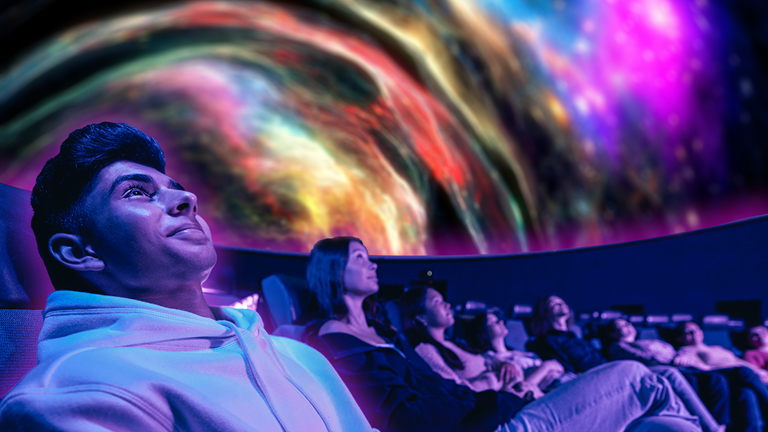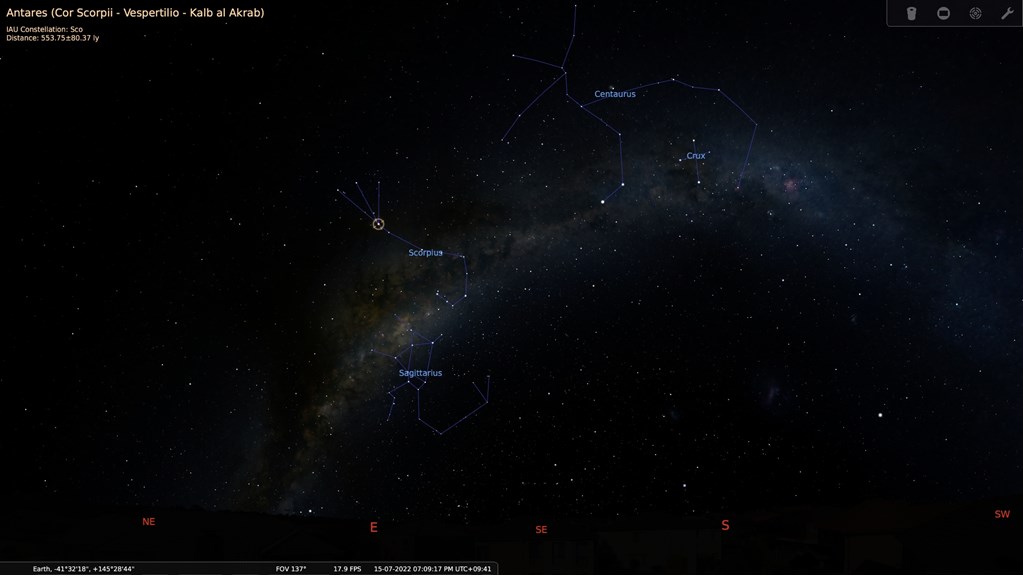Skynotes: July 2022
Upcoming events
Melbourne Sun times
| Date | Rise | Solar noon§ | Set | Day length |
|---|---|---|---|---|
| Fri 1st | 7.36am | 12.23pm | 5.11pm | 9.34 hrs |
| Mon 11th | 7.34am | 12.25pm | 5.16pm | 9.42 hrs |
| Thu 21st | 7.29am | 12.26pm | 5.23pm | 9.54 hrs |
| Sun 30th | 7.21am | 12.26pm | 5.31pm | 10.10 hrs |
§ When the sun is at its highest, crossing the meridian or local longitude.
Moon phases
| Phase | Date |
|---|---|
| First Quarter | Thu 7th |
| Full Moon | Thu 14th |
| Third Quarter | Thu 21st |
| New Moon | Fri 29th |
Moon distances
Wednesday 13th is lunar perigee (nearest to Earth) at 357,264 km.
Tuesday 26th is lunar apogee (furthest from Earth) at 406,274 km.
Planets
Mercury, unlike last month, is not visible as it rises too close to the Sun.
Venus is still visible but only for short time as it draws ever closer to the Sun. It rises around 6am but then fades in the morning light.
Earth reaches aphelion this year on Tuesday 4 July (Melbourne time) which is its furthest distance from the sun at 152.1 million km. Our planet’s largely elliptical orbit brought Earth to perihelion (closest to the sun) on 4 January when it was 5 million km closer. Earth’s orbit is determined by the gravitational influence of the sun, the other planets, but above all by the moon which is so close to us. Interestingly, Earth’s orbit slowly changes from elliptical to almost circular and then back again over a period of 100,000 years, which shows how dynamic planetary orbits can be over long-time scales.
To see the 5 million km difference as seen from Earth, which is a change of about 3% in the sun’s apparent diameter, visit Astronomy Picture of the Day (APOD) for 9 January 2020 and a striking image by Ian Griffin of Otago Museum.
Every day APOD features a marvellous image with expert explanations and links to follow up, and its archive of previous days is a rich resource to explore and enjoy.
Enjoy this video on Perihelion and Aphelion from the Geographer Thinking series.
Jupiter can be seen brightly from 11.30pm in the east and as it moves high in the north during the night before being overwhelmed in the early morning light.
Saturn, although fainter, can be seen rising at 8.30pm, and as it moves high in the east then north before finally fading low in the west as dawn approaches.
Meteors
This month, there are no strong meteor showers but on 27–30 July the Southern Delta Aquariids should be visible in the constellation of Aqaurius, the water bearer high in the north. The meteors will radiate from near Skat (Delta Auquarii), the fourth brightest star in the constellation. The best time to look is a few hours before dawn when perhaps 20 meteors per hour could be seen.
Discover more at
Stars and constellations
A Stellarium view from north-east to south-west for 7pm in July. Scorpius, Sagittarius, Centaurus and Crux (Southern Cross) are featured. The red giant star Antares in Scorpius is marked and below the scorpion’s tail in Sagittarius is the famous Tea Pot asterism which sits vertically; handle below, lid to the left and spout above.
Alpha and Beta Centauri are the two very bright stars low in Centaurus and, as the Pointers, they lead the eye to nearby Crux high in the south. The Milky Way’s broad band arcs across the sky from east to west at this time of the night.
In the west
Canis Major (and Sirius, brightest of the night time stars) and Canis Minor (and Procyon) are still visible but lower this month in the west and north-west respectively.
In the north
High in the north is Virgo and the star Spica, while Leo is in the north-west recognisable by its upside-down hook pattern of stars with the star Regulus.
In the east
Scorpius rises much higher in the south-east with the red-giant star Antares easily seen even from areas with city lights. Below and now fully revealed is the centaur-archer Sagittarius whose bow and arrow forms the famous asterism the 'Tea Pot'.
In the south
The Southern Cross or Crux is high up directly south and, to the left, are the Pointers (Alpha and Beta Centauri which mark the front hooves of the other celestial centaur).
The billions of distant stars and numerous dark dust clouds of the Milky Way forms a broad band across the evening sky from east to west. From our southern perspective we enjoy a superb view of the galaxy quite different to most northern hemisphere locations.
Easy to see in the south-west are the intriguing irregularly shaped neighbouring galaxies, the Large and Small Clouds of Magellan, which are special features of our southern skies.
Visible are the bright stars Canopus in the south-west and Achernar closer to the horizon in the south.
Brightest stars seen from Earth
This winter in the evening it will be easy to see in one view the four brightest stars as seen from Earth at night. They are all visible in our southern hemisphere sky. In order of brightness they are Sirius (low in the west in Canis Major), Canopus (low in the south-west in Carina), Alpha Centauri also known as Rigel Kentaurus and Toliman (high in the south-east in Centaurus), and Acturus (low in the north in Bootes).
Enjoy VectorGlobe’s video 10 Brightest Stars in the Night Sky.
International Space Station
The International Space Station orbits every 90 minutes at an average distance of 400 km appearing like a bright star moving slowly across the night sky. Here are some of the brightest passes expected this month over Melbourne and Central Victoria.
Evening
- Wed 6th 7.11pm to 7.14pm West-South-West to West
- Thu 7th 6.23pm to 6.29pm South-West to East-North-East
Morning
- Tue 19th 6.58am to 7.05am North-West to South-East
- Fri 22nd 6.10am to 6.15am West to South-East
Heavens Above gives predictions for visible passes of space stations and major satellites, live sky views and 3D visualisations. Be sure to first enter your location under 'Configuration'.
On this day
1st 1770, closest pass to Earth of any known comet: Comet Lexell at 2.2 million km (roughly 5.5 times the moon’s distance).
4th 1054, Chinese and other astronomers witness the supernova explosion that produced the Crab Nebula 6500 light years away.
4th 2005, Deep Impact probe (USA) crashes into Comet Tempel 1 to analyse its composition.
4th 1868, birth of Henrietta Swan Leavitt who established the luminosity-period relationship of Cepheid variable stars allowing Edwin Hubble to show 'nebulae' were other galaxies beyond our own.
5th 1687, Isaac Newton’s Mathematical Principles of Natural Philosophy is published laying the groundwork for much of modern science.
7th 1959, Venus’ diameter is determined and its atmosphere analysed by its occultation of the star Regulus in Leo.
8th 2011, the space shuttle Atlantis (USA) is launched on the final mission for the shuttle program.
10th 1962, first communications satellite Telstar (USA) is launched as an experiment in trans-Atlantic communication.
11th 1979, Skylab 1 (USA) is destroyed during re-entry over Western Australia and scatters debris over a wide area.
14th 1965, Mariner 4 (USA) makes the first controlled flyby of Mars and returned the first close-up images of the planet.
15th 1975, Apollo-Soyuz Test Project mission occurs. An American Apollo module with three astronauts (launched with the last Saturn rocket) and a Soviet Soyuz craft with two cosmonauts rendezvous and dock in Earth orbit.
16th 1746, birth of Giuseppe Piazzi, discoverer of the dwarf planet Ceres in the asteroid belt.
16th 1969, Apollo 11 (USA) launches to moon for the first lunar landing 5 days later.
16th 1994, Jupiter is struck by over twenty fragments of Comet Shoemaker-Levy 9 with Earth-based telescopes and the Hubble Space Telescope observing the unique event.
20th 1969, Apollo 11 (USA) Moon landing when Lunar Excursion Module 'Eagle' touched down in the Sea of Tranquility.
21st 1969, first humans set foot on another world. At 12.39pm AEST Neil Armstrong becomes the first person to step on the Moon. He is followed 20 minutes later by Buzz Aldrin, while the third Apollo 11 astronaut, Michael Collins, remains in the Command Service Module 'Columbia' in lunar orbit. Armstrong and Aldrin are on the moon for 21 hours, 36 minutes.
22nd 1784, first use of parallax and hence calculation of the distance to a star by Friedrich Bessel.
23rd 1995, Alan Hale and Thomas Bopp discover comet now named after them.
23rd 1928, Vera Rubin born – famous for analysing rotation rates of galaxies.
24th 1969, first lunar landing mission, Apollo 11, ends with Command Module splashdown in the Pacific Ocean.
29th 2005, dwarf planets, Eris and Makemake, are announced leading to Pluto becoming a dwarf planet as well.
30th 1971, first Lunar Rover used on the moon in Apollo 15 Mission.

